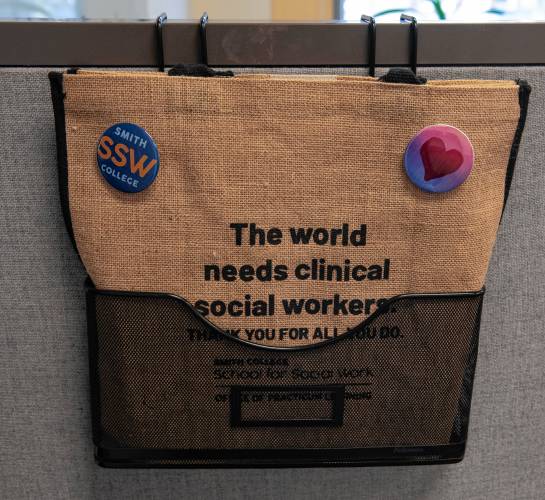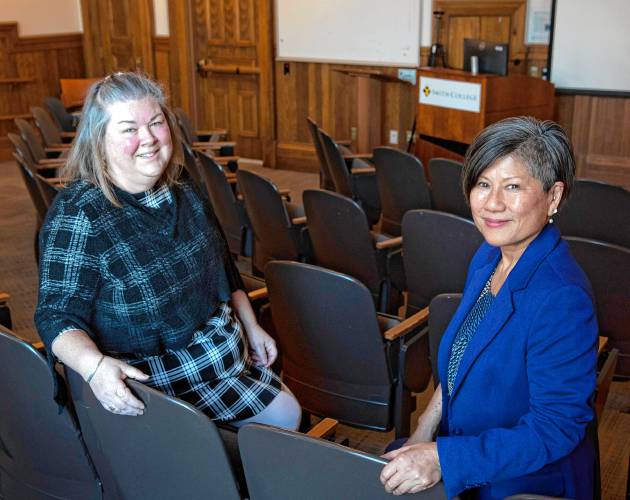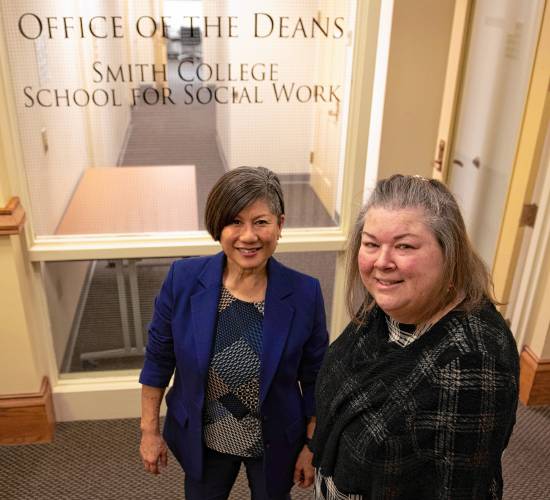Massachusetts bill aims to lessen social work burden
| Published: 12-31-2024 12:43 PM |
NORTHAMPTON — Becca Frank, a clinical social worker at ServiceNet in Springfield, keeps careful boundaries in place to prevent career burnout.
“My phone is off at 5, which is why you couldn’t get ahold of me,” Frank says. “And then I have a life.”
Social workers are responsible for 60% of all mental health care in the United States. Yet in a study published by the British Journal of Social Work in 2024, researchers found that approximately 54% of social workers report at least a moderate level of emotional exhaustion. Although 78% of social workers also reported a moderate to high level of personal accomplishment in their jobs, the findings highlight the disparity between the importance of social work and the lack of resources to mitigate mental health struggles in the field.
With mental health emerging as a dire crisis, the shortage of social workers and the scarcity of resources for those in the field require immediate attention, advocates say. Mental Health America, a nonprofit organization, found that almost 60 million Americans suffer from mental illness nationwide, a significant increase from the 44 million reported in 2019. Locally, the 2023 Prevention Needs Assess ment Survey found that a staggering 17.1% of Hampshire County teenagers reportedly engaged in self-harm, with a worrying 15.5% contemplating suicide.
Yet the U.S. Bureau of Labor Statistics predicts “a substantial deficit of 74,000 social workers each year for the next decade,” according to the Columbia School of Social Work.
“Clinical social workers are the leading mental health provider in the country,” says Marianne Yoshioka, the Dean of the Smith College School for Social Work, making the increasing need for mental health support and the rapidly declining number of students going into social work a troubling problem.
In an attempt to increase support for current social workers and encourage more students to enter the occupation, a bill called the SUPER Act is under consideration in the Massachusetts Legislature. This act would provide stipends for students, incentivize licensed social workers to mentor student trainees, and remove the Association of Social Workers Board exam from master’s degree requirements.
The SUPER Act, which stands for Social Work Uplifting Practices and Exam Removal, aims to increased the workforce by tearing down barriers to the profession. A state-funded grant program would provide stipends for master’s degree students in unpaid work-based placements, prioritizing first-generation students, students of color, and marginalized communities.
Article continues after...
Yesterday's Most Read Articles
 Long-vacant former Faces spot in Northampton gets new tenant
Long-vacant former Faces spot in Northampton gets new tenant
 Here come the sweetness: Four new businesses prepping to open in downtown Northampton
Here come the sweetness: Four new businesses prepping to open in downtown Northampton
 Local ‘Hands Off!’ standouts planned as part of national effort
Local ‘Hands Off!’ standouts planned as part of national effort
 Northampton schools probe staff response to student’s unfulfilled IEP
Northampton schools probe staff response to student’s unfulfilled IEP
 Area property deed transfers, April 4
Area property deed transfers, April 4
 Sabadosa, Velis push for state endometriosis task force to raise awareness about little-known illness
Sabadosa, Velis push for state endometriosis task force to raise awareness about little-known illness
“This bill represents an opportunity to level the playing field,” says state Sen. Jo Comerford, D-Northampton.
Funding for the bill exists. Massachusetts allocated $25 million of the $190 million received in federal funding during COVID to behavioral health supports and placement stipends. “We weren’t asking the state for new funds,” said Brianna Silva, membership and advocacy manager of the Massachusetts Chapter of the National Association of Social Workers. “Eventually the state would need to decide to fund the program, but at this moment in time they could’ve used those federal funds.”
In the first Massachusetts House session, the SUPER Act passed through the Economic Development Bill but was cut from the final legislation. Despite the setback, “the bill did really well for its first session,” Silva says. “Unfortunately, we have to start all over in the legislative process.” The bill will be refiled in January.
The National Association for Social Workers, or NASW, reports that states that have removed the exam at the non-clinical level, such as Rhode Island, have had a 160% increase in new master’s level social workers. The act would greatly remove structural barriers to entering social work, supporters say, diversifying the field and increasing employees to keep up with the rising mental health crisis. In addition to removing the exam, stipends for graduate students could turn the tide in increasing the number of students who enter the field.
“Smith [social work] students are going into their internships unpaid for 30 hours a week,” says Katya Cerar, senior director of practicum learning at Smith College’s School of Social Work. “Some of our students do get a stipend, but it’s very few. I would say it hovers around 25% of all of our placements.”
This leaves 75% of students at Smith’s School for Social Work having to find another source of income while working full-time at their placement. This struggle is not specific to Smith, with students from across the country struggling to finance their higher educations.
With the SUPER bill still working its way through state government, social workers continue to struggle with insufficient resources and mental health challenges. “It is striking how intense burnout can be for some people,” Hadley psychotherapist Joey Dehais says. Social workers are exposed to their clients’ traumatic experiences daily, and by extension have to cope with emotions similar to those of the family of the client.
Secondary traumatic stress (STS) is experienced when someone is indirectly exposed to a traumatic event through the experiences of another individual. According to the Oxford Academic Journal for Social Work, STS is a common issue that social workers deal with, as they frequently work with individuals who are coping with traumatic events in their life, sometimes leading to fatal or non-fatal suicidal behavior.
Studies have shown that while social workers understand and advocate for the value of self-care and maintaining a work-life balance, they often report that they do not practice these behaviors. The number of social workers who reported STS as well as post-traumatic stress (PTS) is particularly high among those who work with clients with suicidal behavior, according to a 2011 study published in the journal Social Work.
Despite being a field that helps to keep the rest of society afloat, social work is consistently undervalued, experts in the field say. Social work has a stigmatization as a profession defined by mental health struggles and a high-stress work environment. However, research suggests that the issue isn’t with the work itself, but with the lack of resources available to workers.
“The people who are there to serve you will be some of the least paid folks,” explains Yoshioka. “It’s the way that in our society we devalue that work, which is a chronic professional issue, and social work as well.”
According to the NASW, the median salary for social workers is $52,000. Meanwhile, most professions that require a master’s degree have a median pay of $60,000 or higher, with the top 50% making closer to $80,000 or higher. At Smith College, “our students are applying for food stamps and EBT and DTA to help pay utilities,” says Cerar. “For a job this important, that should not be the state of things.”
One of the biggest challenges facing social workers in the field is insurance, Comerford says. Insurance companies, specifically public health insurance like MassHealth, have extremely low reimbursement rates for the full costs of treatment and time.
“Social workers don’t have an incentive right now to take clients on MassHealth because they don’t get enough reimbursement,” Comerford says.
Not only does public health insurance pay social workers poorly, it also complicates the process of obtaining money from federal sources for the clients they serve. The inability to effectively help their clients contributes to decreased job satisfaction and burnout for social workers.
Because of the uncertain schedule and the lack of workers in the field, there is a particular need for social workers who are willing to work the hours necessary to see children. “We’re really in crisis in terms of children right now. Most children are usually seen after 3:30 in the afternoon and into the evening or on weekends. And most new social workers don’t want to work that schedule,” Cerar said.
Despite their leading role in care, Dehais believes unnecessary pressure is placed on workers in the field. “I think it’s a misconception among social workers in addition to those outside of [the field],” Dehais shares. “I feel really strongly that we are not here to save the day.”
Alongside supporting clients’ mental health, social workers often have to support their colleagues as well.
“The biggest resource for me is my coworkers and my supervisors,” Frank says. “If I didn’t have them, I would be turning to my peers and the people I went to social work school with.”
Ariel Pliskin, a clinical supervisor and psychotherapist in Northampton, echoes this sentiment, saying they are both “receiving support and providing it for the therapists on the team.” While fostering community is important, the additional responsibilities falling onto social workers inhibit their ability to do their job and sustain themselves in the long run, workers say.
To prevent burnout, some social workers take leave to recover. “You have to have those breaks to walk away. To step back,” Yoshioka said. But the ability to rejuvenate is often a benefit reserved for private practices, a luxury not common in more community-focused spheres.
Yet burnout is not an experience for everyone in the field. For Dehais, instead of strong boundaries, they thrive on relationships built with clients. Dehais sees their work as an extension of their personal growth. Through the relationships Dehais builds, they gain as much as the client does.
“This work that I do feels so intertwined with the personal journey I’m on,” Dehais said. “It doesn’t feel like this work takes from me in the same way that I think some others feel it does.”
This article was written by Smith College students in a journalism course taught by Naila Moreira, in collaboration with the Gazette and with guidance from journalist Lauren Katz. The students engaged in a local crowdsourced-reporting project asking Gazette readers and the 29,000-member Northampton, MA Facebook group what topics area residents would like to see reported in the news media. Students voted on and reported selected ideas as teams.










 Making News in Business, April 4
Making News in Business, April 4
